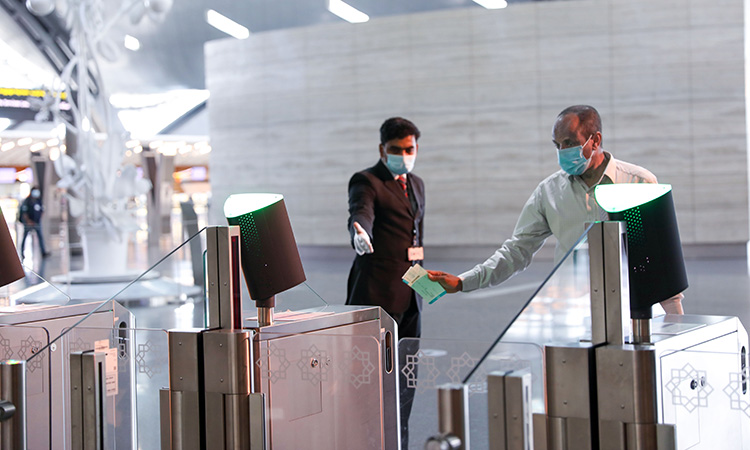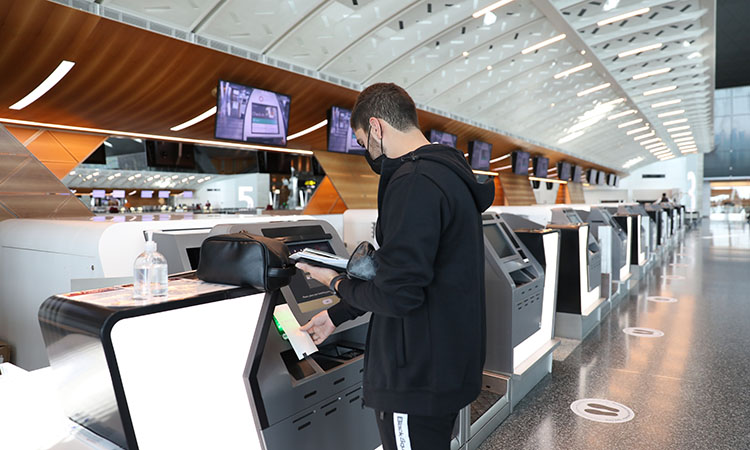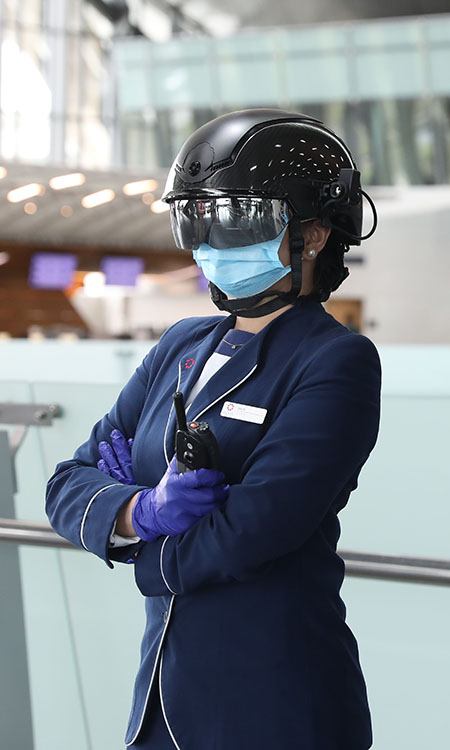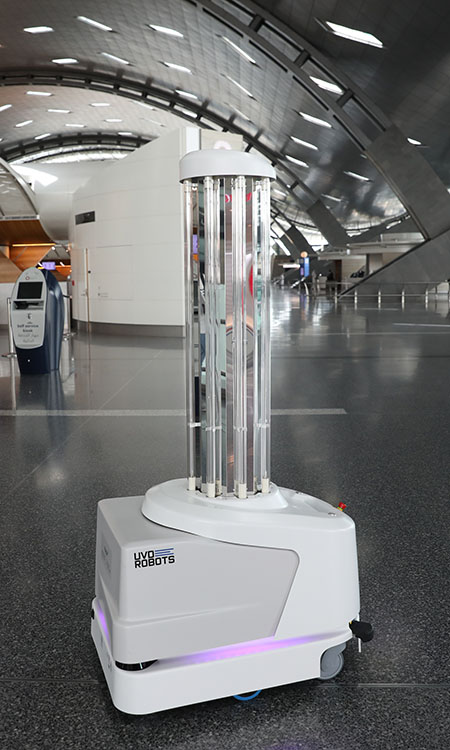Adapting to the new normal and delivering a safe airport experience
- Like
- Digg
- Del
- Tumblr
- VKontakte
- Buffer
- Love This
- Odnoklassniki
- Meneame
- Blogger
- Amazon
- Yahoo Mail
- Gmail
- AOL
- Newsvine
- HackerNews
- Evernote
- MySpace
- Mail.ru
- Viadeo
- Line
- Comments
- Yummly
- SMS
- Viber
- Telegram
- Subscribe
- Skype
- Facebook Messenger
- Kakao
- LiveJournal
- Yammer
- Edgar
- Fintel
- Mix
- Instapaper
- Copy Link
Posted: 15 February 2021 | Hamad International Airport | No comments yet
Since March 2020 and the official declaration from WHO that the outbreak of COVID-19 had officially become a pandemic, Hamad International Airport has worked hard to ensure that its passengers could continue to travel in a safe airport environment. Through the implementation of new technologies and increased cleaning efforts, Hamad has continuously adapted to the ‘new normal’ of air travel in a bid to encourage travellers back to the skies.


Credit: Hamad International Airport
2020 was a defining year for Qatar’s Hamad International Airport (DOH). As the World Health Organisation (WHO) declared the coronavirus outbreak a pandemic in March 2020, DOH was tasked with ensuring safe, secure and uninterrupted airport operations against the backdrop of global travel disruptions. DOH, as the preferred transfer hub, rose to the occasion with the utmost dedication, ensuring that its goal of sustained connectivity could be met despite the unprecedented crisis.
Passengers have always been at the heart of DOH’s strategy, leading the airport to transform its airport experience amid the pandemic”
Passengers have always been at the heart of DOH’s strategy, leading the airport to transform its airport experience amid the pandemic. As the airport worked to ensure passenger wellbeing and rebuild confidence in air travel, it introduced new health and safety processes to align with WHO guidelines while deploying passenger-empowering technologies in line with its visionary approach.
Adapting to the new normal
The airport’s transformation has encompassed technological adoptions, passenger-centric solutions and awareness campaigns on how to curb the spread of the virus. At the start of the outbreak, DOH launched an ongoing campaign across its terminal and online platforms to inform and update passengers about its airport operations and how they were adapting to the new normal. The airport developed a hygiene advisory guided by WHO, which is publicised across all passenger touchpoints and screens across the terminal. With global travel restrictions changing on a regular basis, DOH has also published Frequently Asked Questions (FAQs) on its website to provide timely information and address traveller concerns. These FAQs are regularly updated and shared through the airport’s social media channels.


Credit: Hamad International Airport
As part of its technological adoptions, DOH was the first airport to request, from its solutions-provider, an innovative prototype of cabin baggage x-ray screening featuring UV-C disinfectant lights retrofitted into the scanners’ trail return systems. The fruitful collaboration resulted in the successful creation and trialling of the prototype, as well as its deployment in record time.
The airport not only managed to acquire leading technological solutions but also developed its own. This agile and effective approach helped to ensure that innovative solutions were quickly applied to adapt to the new normal. Using the latest in computer vision and artificial intelligence (AI), DOH’s internal teams developed an automated facial detection system to ensure the wearing of masks. The home-grown technology was rapidly integrated into DOH’s thermal scanning stations.
Touchless technologies


Credit: Hamad International Airport
To meet the elevated demand for sanitising services, DOH rapidly introduced a series of touchless technologies, including disinfectant robots and UV-C baggage disinfection tunnels. The disinfectant robots, which are fully autonomous mobile devices that emit concentrated UV light, are effective in eliminating the majority of infectious microorganisms. DOH also invested in Smart Screening Helmets. Portable, safe and effective, these intelligent helmets enable contactless temperature measurement using advanced technologies, such as infrared thermal imaging, artificial intelligence and AR display. Currently, DOH is trialling the use of disinfection tunnels for baggage trolleys, eliminating the need for manual sanitisation between uses.
DOH also worked to minimise risk from outside the airport, installing UV-C baggage disinfection tunnels in its terminal to decontaminate inbound luggage from arriving passengers. Internally, hygiene standards were stepped up to limit human contact at security checkpoints, making the process safer and faster, for both staff and transferring passengers. Transferring passengers were able to move through security checkpoints faster, and without having to remove electronic devices from their bags, thanks to C2 technology, a ground-breaking security screening system. DOH’s self-service passenger experience at check-in, bag-drop and immigration allowed passengers to move through key touchpoints with minimal physical interaction.
DOH showed leadership in ensuring the adoption of supplementary safety and security measures for both its staff and passengers. The airport aligned its operations to adjust to the new normal by following WHO guidelines regarding frequently sanitising key touchpoints while implementing physical distancing measures across the terminal. Floor stickers and signage were swiftly installed to remind passengers about the importance of physical distancing, and seating arrangements were made across the airport to allow for such distancing, including at boarding gates, where crowding tends to occur.
DOH ensured that passengers continued to enjoy its outstanding multi-dimensional offerings with peace of mind by implementing precautionary measures”
As a diverse lifestyle destination on its own, DOH ensured that passengers continued to enjoy its outstanding multi-dimensional offerings with peace of mind by implementing precautionary measures at DOH retail outlets, food outlets and food courts, including cashless purchases to limit contact, distance seating and thermal screening.
By the end of 2020, DOH had introduced 33 thermal screening cameras, five UV robots, five thermal screening helmets, 265 hand sanitiser paddle machines, eight PPE vending machines, 258 acrylic barriers in high-contact areas and check-in counters, 3,558 floor-stickers for social distancing and 14 disinfecting tunnels to mitigate the spread of COVID-19.
The airport’s successful acquisition and deployment of pioneering smart solutions during the pandemic highlights its commitment to operational excellence, and its dedication to the transformation of its airport experience to foster connectivity for passengers and deliver essential goods. These efforts were recognised by industry leaders throughout the year.
Recognition of DOH’s smart solutions


Credit: Hamad International Airport
In May 2020, DOH was awarded the ISO 22301:2012 Business Continuity Management System Certification by British Standards Institution (BSI). The certification is a testament to DOH’s commitment to operational excellence and resilience in the face of an unprecedented crisis like COVID-19. In November 2020, DOH also became the first global entity to be certified by BSI for its COVID-19 Aviation Health Safety Protocol Implementation, following BSI’s diligent audit across the terminal, in line with the International Civil Aviation Organization’s (ICAO) Civil Aviation Recovery Taskforce (CART).
The certification highlighted the efforts of DOH that successfully contributed to rebuilding passenger confidence and boosting air travel, particularly during times of global crises.
In December 2020, DOH became the first airport in the Middle East and Asia to be awarded a 5-Star COVID-19 Airport Safety Rating by Skytrax. The audit entailed a rigorous evaluation of DOH’s health and safety measures. Inspectors evaluated the application and efficacy of DOH’s physical distancing protocols, along with the quality and availability of hand hygiene facilities across the terminal. Cleaning processes were assessed for their effectiveness, to identify any potential sources of contamination, and to ensure that the airport’s hygiene standards complied with Skytrax’s stringent requirements.
The airport’s operational foresight and technological investments over the past year, to meet the challenges presented by COVID-19, has given it an edge”
The Skytrax audit also reviewed the usage of personal protective equipment (PPE) among staff, as well as the implementation of thermal temperature screening procedures, face mask regulations and the overall cleanliness and hygiene standards across the airport, all of which lead to a holistic, safe and secure passenger experience, and has allowed DOH to keep its doors open throughout the pandemic.
The airport’s operational foresight and technological investments over the past year, to meet the challenges presented by COVID-19, has given it an edge in anticipating short- and long-term challenges and has contributed to its prominent position as the globally preferred travel hub.
Considering the positives
DOH also added new airlines to its portfolio, with Indian airline Vistara starting flights to Qatar in November 2020, and Air Canada, the flagship carrier of Canada, landing its inaugural flight at DOH in December 2020, making Hamad the only airport in the Middle East to operate a scheduled service by a North American carrier. In January 2021, regional airline operations between Qatar and several Gulf Cooperation Council (GCC) nations resumed, with Qatar Airways and other gulf-based carriers recommencing their services to many of these destinations and further enhancing DOH’s connectivity.
In the past year, DOH has demonstrated its ability to harness pioneering solutions to adapt to today’s global challenges, once again ensuring that travel remains a safe experience for all”
Additionally, the airport made significant advancements in its diverse lifestyle offerings during 2020. Despite the pandemic, the airport and its strategic partner, Qatar Duty Free (QDF), continued to innovate and invest in the evolution of retail and food and beverage (F&B) experiences. The airport became home to the first Loro Piana airport boutique in the Middle East, and the first pop-up concepts by Penhaligon and Carolina Herrera in December 2020. The partnership has resulted in award-winning achievements, such as the ‘Best Airport Retail Environment’ at the 2020 Travel Retail Awards.
Providing an agile airport experience will be critical to the success of all airports, domestic and international, in the years to come. In the past year, DOH has demonstrated its ability to harness pioneering solutions to adapt to today’s global challenges, once again ensuring that travel remains a safe experience for all.
Related topics
Airport crisis management, Airside operations, Contactless / Touchless technology, COVID-19, New technologies, Passenger experience and seamless travel, Retail, Safety, Terminal operations
Related airports
Related airlines
Related organisations
British Standards Institution (BSI), International Civil Aviation Organization (ICAO), Skytrax, World Health Organization (WHO)


















